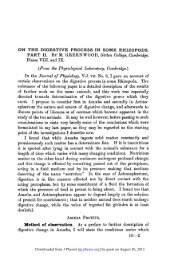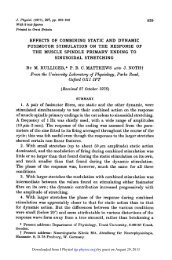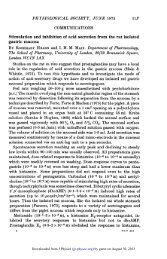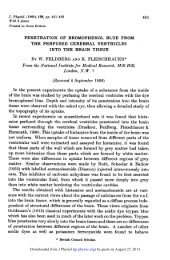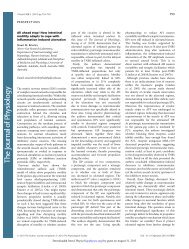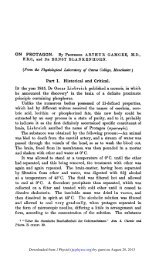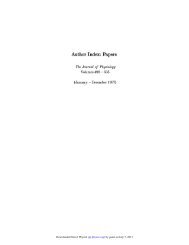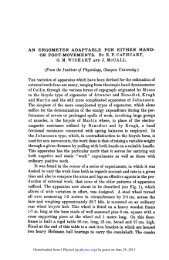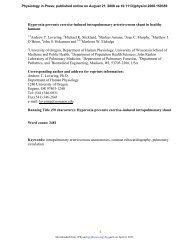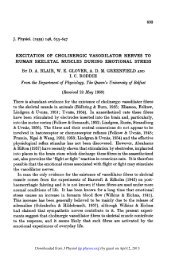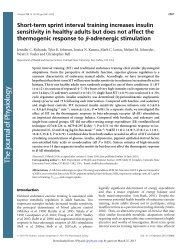MILTON AND SABINE WENDLANDT
MILTON AND SABINE WENDLANDT
MILTON AND SABINE WENDLANDT
You also want an ePaper? Increase the reach of your titles
YUMPU automatically turns print PDFs into web optimized ePapers that Google loves.
326<br />
A. S. <strong>MILTON</strong> <strong>AND</strong> S. WENDL<strong>AND</strong>T<br />
INTRODUCTION<br />
The results of the present experiments show that the prostaglandin<br />
E1 (PGE1) and E2 (PGE2) exert a strong hyperthermic effect when injected<br />
in minute amounts into the third cerebral ventricle of the<br />
unanaesthetized cat and rabbit.<br />
Prostaglandins have been shown to be natural constituents of the central<br />
nervous system of various species including cats and rabbits (Samuelsson,<br />
1964; Coceani & Wolfe, 1965; Ambache, Brummer, Rose & Whiting,<br />
1966; Horton & Main, 1967a). The distribution of the E and F series of<br />
prostaglandins has been investigated in the central nervous system of the<br />
dog by Holmes & Horton (1968 a), who found them not only in the cerebral<br />
cortex, cerebrum and spinal cord, but also in those parts of the brain which<br />
line the cerebral ventricles such as the hippocampus, caudate nucleus and<br />
hypothalamus. They appear to be released from these structures into the<br />
perfused cerebral ventricular system as shown in anaesthetized cats<br />
(Feldberg & Myers, 1966) and dogs (Holmes, 1970). According to Holmes<br />
the concentration of the E series of prostaglandins increases fourfold on<br />
perfusion with 5-hydroxytryptamine. Prostaglandins were also detected<br />
in superfusate from the cerebral and cerebellar cortex (Ramwell & Shaw,<br />
1966; Wolfe, Coceani & Pace-Asciak, 1967).<br />
No definite physiological function has so far been attributed to the<br />
prostaglandins in the central nervous system but they have been shown<br />
to modulate nerve cell activity (Avanzino, Bradley & Wolstencroft, 1966;<br />
Hoffer, Siggins & Bloom, 1969; Kaplan, Grega & Buckley, 1968; Duda,<br />
Horton & McPherson, 1968; Phillis & Tebecis, 1968) and to alter animal<br />
behaviour, to produce signs of sedation, stupor and catatonia in cats, to<br />
antagonize electrical and leptazol induced convulsions in rats and to<br />
affect muscle tone and reflex activity in various species (for references see<br />
Horton, 1968). The results of the present experiments suggest that PGE1<br />
and PGE2 by their hyperthermic actions may play a role in temperature<br />
regulation and that this may be one of their physiological functions in the<br />
hypothalamus.<br />
METHODS<br />
Cats and Dutch rabbits of either sex weighing between 2-5 and 3-5 kg were used.<br />
Cannulation of third ventricle. The cats were anaesthetized with pentobarbitone<br />
sodium (40 mg/kg i.P.). The head of the cat was held in a stereotaxic apparatus, the<br />
eardrums being protected by rubber caps fitted onto the earbars. Under aseptic<br />
conditions, a hole 1-5 mm in diameter was drilled through the bone in the midline<br />
and 12-5 mm anterior to the interaural line. A stainless-steel guide cannula (20-gauge<br />
needle tubing) with a rubber-capped cannula head was lowered through the hole in<br />
the skull to 6 mm above the interaural line. This placed the guide cannula in the



